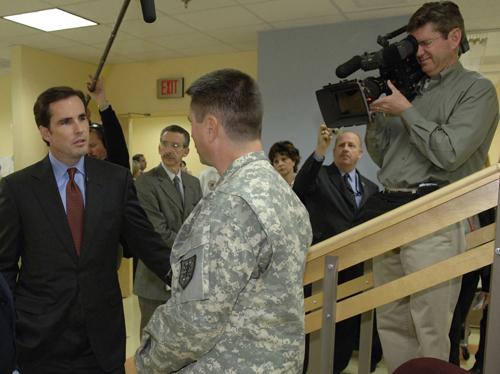Special to air about anchor’s recovery
Feb 27, 2007
Last updated on May 12, 2016 at 08:23 a.m.
NEW YORK – Bob Woodruff searched for the word, but it wasn’t quite there.
It was an internal organ, that he knew. He was describing a soldier’s injuries when indecision stopped him. “Intestines,” a producer sitting to his left in an ABC News conference room Monday gently reminded him.
The newsman met with reporters for the first time since a roadside bomb in Iraq tore off part of his skull 13 months ago. ABC News is airing a prime-time special, “To Iraq and Back: Bob Woodruff Reports,” about Woodruff’s recovery and the plight of other brain-injured Iraq veterans at 10 p.m. EST Tuesday. A book he co-wrote with wife Lee also goes on sale Tuesday.
Only in small moments – a dropped word, momentary confusion at a question, a startled look upon hearing a cough – were Woodruff’s injuries evident. At one point he used the word “news” in place of “knowledge,” but caught and corrected himself.
Get The Daily Illini in your inbox!
Small pockmarks from shrapnel on the left side of his face and neck were visible. Doctors said it was a remarkable recovery for someone who had come so close to death.
Upon first emerging from a 36-day coma following the blast, Woodruff couldn’t name any of the 50 states or even recall his twin 6-year-old daughters – not just their names but their very existence.
“Will I get back 100 percent?” he asked. “Probably unlikely. Maybe if I get somewhere in the 90s, that would be pretty damned good.”
He was hurt on his 28th day as “World News Tonight” co-anchor, on Jan. 29, 2006. Woodruff was riding in an Iraqi army tank in Taji, Iraq, his head and upper body exposed through the hatch, when the bomb went off.
“When it actually exploded, I don’t remember that,” he said. “But I do remember immediately at that moment that I saw my body floating below me and a kind of whiteness.”
He briefly lost consciousness, fell back into the tank and woke up to see cameraman Doug Vogt across from him.
“I looked up at Doug and I saw his eyes big and afraid and just asking him if we were still alive and that’s the last thing I remember,” Woodruff said.
He’d been lucky, in one sense. A rock the size of a silver dollar punctured his neck and lodged just next to a vital artery. He was evacuated quickly to medical facilities. But during his coma, no one knew what kind of Woodruff would emerge – if he would at all.
The ABC special illustrates the process of turning the brain back on again. In film of him taken months later, Woodruff stares blankly at pictures of a hammer and scissors, not knowing what to call them. His children laugh with him as he repeatedly fails to pronounce “belt buckle.”
A camera catches him crying when he returns to National Naval Medical Center room in Bethesda, Md., where his wife explained that during visits she’d steer their children to the side of the room where his injuries looked less severe.
The most difficult part of his ordeal was knowing what his family experienced. “Every time I see my wife crying, that kills me a little bit,” he said Monday.
Woodruff now goes to therapy for his injuries once a week. But reporting and even attending Monday’s news conference, where he is forced to think on his feet, are part of his therapy, too, he said.
Two-thirds of Tuesday’s special is about how the U.S. government is dealing with veterans returning with brain injuries. Several families contend that the federal government is unprepared, and is also underestimating the number of people returning with brain problems.
“I’ve been given a chance to tell about something I lived through and seen so many soldiers and Marines live through that I think perhaps that was designed in some way, for the same reason perhaps that I didn’t die of this,” he said.






